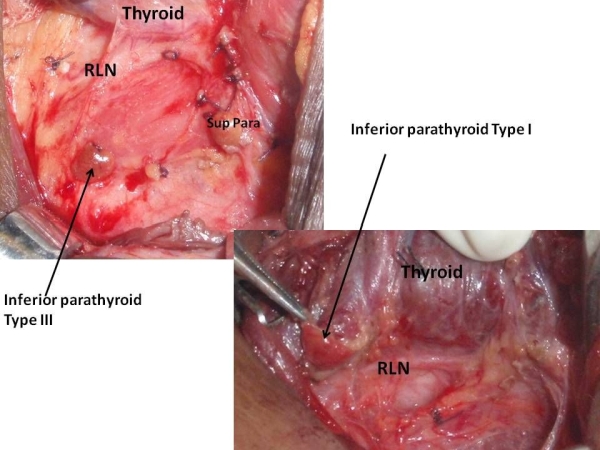A Closer Look at Parathyroid Anatomy During Thyroid Surgery
Abstract
Introduction: With the reduction in mortality from thyroid surgery, surgeons are now concentrating in decreasing the morbidity by improving the dissection technique. Morbidity is related to injuries to the parathyroids, recurrent laryngeal (RLN) and external branch of superior laryngeal nerve (EBSLN). Mostly these are due to technical failure and the variations in the surgical anatomy. In this article we analyse the surgical anatomy of the parathyroids during the thyroid surgery in a set of Indian patients undergoing elective thyroid surgeries.Material and Methods:Retrospective study conducted at a tertiary care centre in South India. Study period was from February 2011 to February 2013. Patients undergoing surgery for benign goitres, T1 and T2 thyroid cancers without lymph node involvement were included. Reoperative cases, advanced thyroid cancers were excluded. Data related to 1168 parathyroids which included 584 superior (SP) and 584 inferior parathyroids (IP) were included in this study.Results: There were 404 thyroid surgeries performed during this period. This included 180 total thyroidectomy (TT) and 224 hemithyroidectomy (HT). Among the HT 138 were left HT and 86 right HT. Mean age was 37.52+/-12.9yrs; mean duration of goitre was 39.49+/-46.82 months. Male: Female ratio was 1:8. The common positions of the superior parathyroids (SP) were in and around the entry point of RLN (95.71%) and that of inferior parathyroid (IP) were around the lower pole in 83.38%. Superior parathyroid could be identified in 97.1% cases and inferior parathyroids in 94.52% cases. 2.9% of superior and 5.9% of inferior parathyroids is not visualized. Permanent hypocalcemia rate was 0.9% in this seriesConclusions: Parathyroid glands are fairly constant in position. Meticulous dissection with blood less field ensures their identification especially those which are ectopically placed. Permanent hypocalcemia is avoided with careful identification and preservation of the parathyroids vascularity.References
References:
1)Bliss RD, Gauger PG, Delbridge LW. Surgeons approach to the thyroid gland: Surgical anatomy and importance of technique. World J Surg 2000;24:891-97
2)Greene WW. Three cases of bronchocele successfully removed. Am J Med Sci 1871;121:80
3)Coller FA, Boyden AM. The development of technique of thyroidectomy: presentation of method used in university hospital. Surg. Gynecol. Obstet 1937;65:495
4)Akerstorm G, Malmaeus J, Bergstorm R. Surgical anatomy of human parathyroid glands. Surgery1984;95:14-21
5)Boyd JD. Development of the thyroid and parathyroid glands and the thymus. Ann R Coll Surg Engl 1950;7(6):455-71
6)Pradeep PV, Jayashree B, Skandha S H. A closer look at laryngeal nerves during thyroid surgery: A descriptive study of 584 nerves. Anat Res Int 2012;2012:490390,doi:10.1155/2012/490390.
1)Bliss RD, Gauger PG, Delbridge LW. Surgeons approach to the thyroid gland: Surgical anatomy and importance of technique. World J Surg 2000;24:891-97
2)Greene WW. Three cases of bronchocele successfully removed. Am J Med Sci 1871;121:80
3)Coller FA, Boyden AM. The development of technique of thyroidectomy: presentation of method used in university hospital. Surg. Gynecol. Obstet 1937;65:495
4)Akerstorm G, Malmaeus J, Bergstorm R. Surgical anatomy of human parathyroid glands. Surgery1984;95:14-21
5)Boyd JD. Development of the thyroid and parathyroid glands and the thymus. Ann R Coll Surg Engl 1950;7(6):455-71
6)Pradeep PV, Jayashree B, Skandha S H. A closer look at laryngeal nerves during thyroid surgery: A descriptive study of 584 nerves. Anat Res Int 2012;2012:490390,doi:10.1155/2012/490390.

